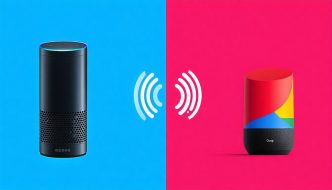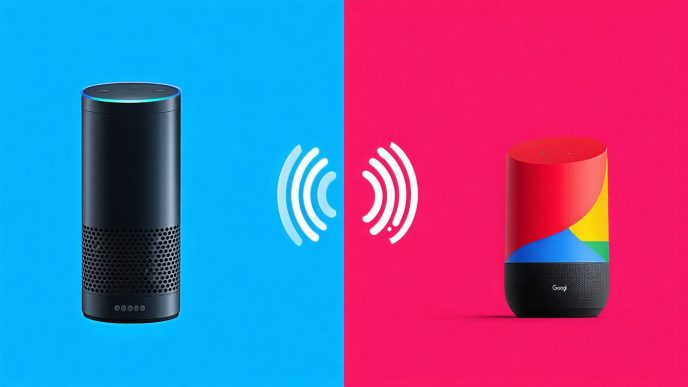Exploring AI Assistants
Introduction to AI Assistants
AI assistants are advanced, voice-activated programs designed to assist users with various tasks through natural language processing and machine learning. Primarily found in smart home devices, smartphones, and other electronic interfaces, they provide convenience and efficiency in daily activities. Users can perform tasks such as setting reminders, controlling smart home devices, or searching for information using simple voice commands. As the technology advances, more people are adopting AI assistants to simplify their lives.
AI assistants can be classified into numerous categories, depending on their functions and applications. Their capabilities range from basic informational queries to complex tasks involving integration with household smart systems. A key focus for those who utilize AI assistants is the seamless interaction across devices and home environments.
Importance of Privacy Concerns
As AI assistants become more integrated into daily life, the issue of privacy and data protection gains significance. Users often question what information AI assistants collect, how it is stored, and how it is utilized. Privacy and AI assistants are critical topics, as individuals share sensitive data with these systems daily.
Concerns regarding the data these assistants gather include:
| Concern | Description |
|---|---|
| Data Collection | Users may be unaware of the extent and type of information collected by AI assistants, which can include voice recordings, preferences, and personal details. |
| Data Storage | The duration for which data is retained and the security measures in place to protect it are paramount considerations for users. |
| Data Usage | How the collected data is used by service providers can significantly impact user trust and satisfaction. Data can be shared with third parties or used for advertisement purposes without explicit user consent. |
Implementing robust privacy measures can alleviate worries. Understanding how different AI systems operate in smart homes, along with their implications, is essential for tech-savvy families and professionals. Users should remain informed about their rights, data permissions, and available privacy settings to ensure a safe and secure digital environment.
For more information on the applications and implications of AI assistants in smart home settings, explore articles on AI assistants and smart homes or AI assistants in appliances.
How AI Assistants Function
Understanding how AI assistants operate provides insight into their capabilities and the considerations surrounding privacy and AI assistants. The functionality of these assistants can be broadly divided into two main areas: voice recognition technology and the command execution process.
Voice Recognition Technology
At the heart of AI assistants is voice recognition technology, which allows devices to understand and interpret spoken commands. This technology relies on sophisticated algorithms and machine learning to convert audio signals into text.
The voice recognition process generally follows these steps:
- Audio Capture: The device captures the user’s voice through a built-in microphone.
- Signal Processing: The captured audio is transformed into a digital signal for analysis.
- Speech Recognition: Advanced algorithms analyze the signal to identify words and phrases.
- Natural Language Processing: The recognized text is processed to understand intent and context.
The effectiveness of voice recognition varies based on several factors, including background noise, accents, and the complexity of commands. Table 1 illustrates the accuracy rates of voice recognition under different conditions.
| Condition | Accuracy Rate (%) |
|---|---|
| Quiet Environment | 95 |
| Moderate Background Noise | 85 |
| Heavy Background Noise | 70 |
For a deeper exploration of similar technologies, refer to our article on voice powered robots.
Command Execution Process
Once the AI assistant accurately recognizes the voice command, it enters the command execution process. This process involves several steps to fulfill the user’s request:
- Intent Recognition: The assistant identifies the user’s intent behind the spoken command.
- Action Retrieval: Based on the recognized intent, the assistant retrieves relevant information or actions from pre-defined data sets or connected services.
- Execution: The assistant performs the requested task, which could range from setting reminders to controlling smart home devices.
- Feedback: After executing the command, the assistant may provide verbal or visual feedback to confirm the action was completed.
Table 2 lists common commands and the corresponding actions performed by AI assistants.
| Command | Example Action |
|---|---|
| “Set a timer for 10 minutes” | Establishes a timer for the specified duration |
| “Play music” | Initiates playback on a connected speaker |
| “Turn off the lights” | Sends a signal to smart home lighting systems |
AI assistants seamlessly integrate into everyday tasks, enhancing convenience and efficiency in smart homes. For insights into how these devices support various use cases, visit our article on AI assistant use cases.
By understanding the intricacies of voice recognition and the command execution process, users can make informed decisions about their privacy and the effectiveness of AI assistants in their homes.
Data Collection by AI Assistants
AI assistants play a significant role in enhancing user experience by interacting seamlessly with various devices. However, understanding what data they collect and how it is stored and utilized is crucial for users concerned about privacy and AI assistants.
Types of Data Recorded
AI assistants can gather various types of data to function effectively. The following table outlines common data categories they may record:
| Data Type | Description |
|---|---|
| Voice Commands | Recorded audio when users give commands or ask questions |
| Interaction History | Logs of previous interactions to personalize responses |
| Account Information | User accounts linked to the assistant for device management |
| Device Data | Information about connected devices within the smart home ecosystem |
| Usage Trends | Patterns regarding how frequently and in what ways the assistant is used |
These different data types allow AI assistants to learn user preferences and improve their performance over time.
Storage and Usage of Data
The way AI assistants store and utilize data varies depending on the provider and the settings specified by the user. Generally, recorded data is stored in secure cloud services, allowing easy access and personalization. The following considerations are important regarding storage and usage:
| Storage Method | Description |
|---|---|
| Cloud Storage | Data is often stored in third-party cloud services, which allows for easy access from multiple devices. |
| Local Storage | In some cases, data may be stored locally on the device, but this is less common for maintaining functionality across devices. |
In terms of usage, the data collected can be employed for:
- Improving the AI’s understanding of user commands.
- Enhancing recommendations based on user interactions.
- Facilitating troubleshooting and support when settings or functionalities change.
Understanding the implications of the data collection practices of AI assistants is essential to navigate privacy concerns effectively. For further insights about how these assistants can enhance smart homes, explore our article on ai assistants and smart homes.
Privacy Measures in Place
Ensuring privacy is a critical aspect of the operation of AI assistants. Various measures are implemented to protect user data and maintain trust. This section will discuss encryption and security protocols as well as user permissions and controls related to privacy and AI assistants.
Encryption and Security Protocols
Encryption plays a vital role in safeguarding the data collected by AI assistants. It is used to encode information in such a way that only authorized parties can access it. This process helps prevent unauthorized access, making it more challenging for malicious actors to exploit sensitive user information.
Key Features of Encryption and Security Protocols
| Feature | Description |
|---|---|
| End-to-End Encryption | Ensures that messages between the user’s device and the AI assistant are secure at all stages. |
| Data Encryption at Rest | Protects stored data on servers, ensuring sensitive information remains confidential. |
| Secure Socket Layer (SSL) | Establishes a secure connection between the user’s device and the AI assistant, enabling safe transmission of data. |
These security measures are crucial for protecting user interactions and ensuring that data is handled ethically. For further information on the importance of security in AI, consider exploring related topics in our ai assistants section.
User Permissions and Controls
User permissions and controls provide individuals with the power to manage how their data is collected and used. AI assistants typically offer settings that allow users to customize their privacy preferences. These settings can include choices regarding data storage, activity logging, and personal data sharing.
Common User Controls for Privacy Management
| Control Type | Description |
|---|---|
| Data Sharing Settings | Users can choose whether to allow data sharing with third parties. |
| Voice History Management | Users can view and delete their voice interactions with the assistant. |
| Device Access Settings | Users can manage which devices are authorized to access their data, enhancing security. |
By providing these controls, AI assistants empower users to take an active role in protecting their privacy. For families and professionals who value technology, understanding these user options is essential for a responsible interaction with AI technologies, particularly for ai assistants and smart homes and ai assistants for elderly support.
Limitations and Risks
AI assistants, while incredibly convenient, come with limitations and risks that users must consider. Understanding these vulnerabilities is essential for ensuring a safe and positive experience with these technologies.
Potential Vulnerabilities
Among the various limitations of AI assistants, security vulnerabilities are a major concern. They can be targets for cyberattacks, leading to unauthorized access to personal data. Some common potential vulnerabilities include:
| Vulnerability Type | Description |
|---|---|
| Data Breaches | Unauthorized access to user data stored by AI assistants. |
| Eavesdropping | Accidental or intentional recording of private conversations. |
| Device Hacking | External attacks leading to control over smart home devices linked to AI assistants. |
In addition to cyber threats, AI assistants may also misinterpret voice commands, potentially leading to unintended actions. This misinterpretation can create privacy issues, especially in sensitive environments.
Mitigating Risks
To counter risks associated with using AI assistants, it’s important for users to employ certain measures that enhance security. Some effective strategies include:
| Strategy | Description |
|---|---|
| Regular Updates | Keeping AI devices updated with the latest software to patch security vulnerabilities. |
| Strong Passwords | Using complex passwords and enabling two-factor authentication where available. |
| Adjusting Settings | Modifying privacy settings to control what data is collected and shared. |
| User Awareness | Educating oneself about privacy and AI assistants to make informed decisions. |
Implementing these strategies can significantly reduce potential risks while using AI technology in smart homes. For more information on how AI assistants integrate into various home settings, explore our article on AI assistants in appliances.
Understanding Consent
Understanding the consent process for AI assistants is essential for users concerned about privacy and data security. When individuals begin using AI assistants, they often agree to user agreements that outline how their data will be handled.
User Agreement Terms
User agreements serve as a critical foundation for establishing the expectations and responsibilities of both the user and the AI assistant provider. These terms typically include details on:
| Aspect | Description |
|---|---|
| Data Collection | Information about what data is collected, which may include voice recordings, commands issued, and usage patterns. |
| Data Usage | Explanation of how the collected data will be used, such as improving voice recognition and personalizing responses. |
| Third-Party Sharing | Information on whether and how data might be shared with third parties, including service providers and advertisers. |
| Duration of Storage | Details on how long data will be retained and the conditions under which it may be deleted. |
Understanding these terms is crucial for users to make informed decisions about their AI assistant usage. Concerns about privacy and AI assistants can arise when users are unaware of how their data might be processed.
Opting Out and Data Deletion
Users have rights regarding their data, including options to opt out of data collection and request deletion of stored information. Many AI assistant platforms provide these functionalities, but the process can vary significantly.
-
Opting Out: Users may have the option to disable certain data collection features. This can often be done through the device settings, allowing individuals to limit data sharing and enhance their privacy.
-
Data Deletion: Users can usually request deletion of their stored data. Some platforms provide a dedicated feature for users to delete their voice recordings and other personal information upon request. Users should consult their specific AI assistant’s settings or help documentation for detailed instructions.
| Option | Details |
|---|---|
| Opt-Out Features | Options to disable data collection, often found in privacy settings or app configurations. |
| Deletion Requests | Capability to delete data through user settings or by contacting customer support, often including confirmation of deleted records. |
By understanding their rights concerning consent, users can navigate the complexities of privacy and AI assistants more effectively. It is important for smart home adopters and tech-savvy families to stay informed about how their information is used and the tools available for managing their data. For further exploration of AI assistants’ applications, check out articles on ai assistants in appliances and ai assistant use cases.
Ethical Considerations
Data Ethics and AI
The rise of AI assistants has brought various ethical considerations to the forefront, primarily surrounding issues of privacy and security. As these assistants collect and process vast amounts of data, it raises questions about how this data is handled and what ethical responsibilities manufacturers have to users.
AI assistants typically store user interactions to improve functionality and personalize responses. However, this creates a potential risk for data misuse. Transparency around data collection and the intentions behind it is crucial. Users need to be informed about what data is being collected and how it is utilized. This fosters trust and encourages responsible usage of AI technologies.
Table 1 illustrates the various types of data collected by AI assistants:
| Type of Data | Description |
|---|---|
| Voice Commands | Speech interactions and questions |
| User Preferences | Personalized settings and frequently used commands |
| Usage Patterns | Frequency and timing of interactions |
| Location Data | Geographical data based on device usage |
Industry Standards and Regulation
To safeguard user data, various industry standards and regulations have been established. These aim to create a framework for ethical practices in the development and implementation of AI technologies. Regulations such as the General Data Protection Regulation (GDPR) in Europe have set a precedent for user data protection, emphasizing user consent and data rights.
In the United States, the landscape is less centralized but evolving. Companies are being encouraged to adopt best practices for data protection. This includes implementing robust encryption methods and clear privacy policies, allowing users to understand their rights regarding data management.
Table 2 summarizes key regulatory measures affecting AI assistants:
| Regulation | Key Features |
|---|---|
| GDPR | User consent, right to access, right to deletion |
| CCPA | Transparency in data collection, opt-out capabilities |
| HIPAA | Health data protection, relevant for some AI applications |
The ongoing discussions around privacy and AI assistants emphasize the need for accountability and ethical decision-making by companies, ensuring that user data is respected and safeguarded. This is particularly pertinent in sensitive contexts, such as when AI assistants are used in smart homes or for elderly support. Expanding on these ethical considerations can guide developers and users alike in navigating the evolving landscape of AI technologies.















